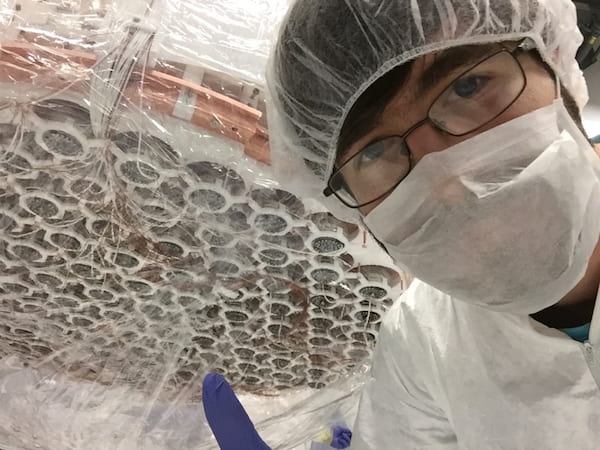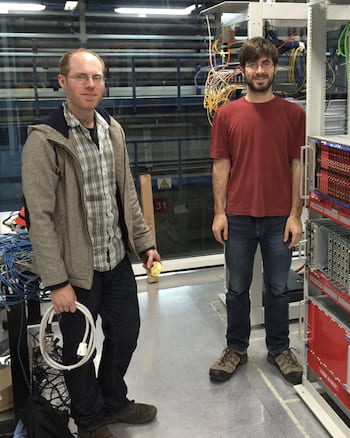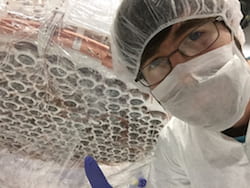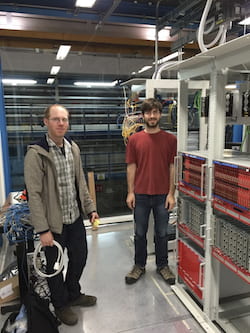NEWS RELEASE
Editor’s note: Links to high-resolution images for download appear at the end of this release.
David Ruth
713-348-6327
david@rice.edu
Mike Williams
713-348-6728
mikewilliams@rice.edu
Elemental old-timer makes the universe look like a toddler
Rice University physicists help discover evidence that xenon isotope’s half-life tops all so far
HOUSTON – (April 24, 2019) – In terms of longevity, the universe has nothing on xenon 124.
Theory predicts the isotope’s radioactive decay has a half-life that surpasses the age of the universe “by many orders of magnitude,” but no evidence of the process has appeared until now.

Rice physicist Christopher Tunnell at the XENON1T experiment in Italy. The collaboration discovered that xenon 124 has the longest half-life ever measured in a material. The element’s half-life is many orders of magnitude greater than the current age of the universe. Courtesy of Christopher Tunnell
An international team of physicists that includes three Rice University researchers – assistant professor Christopher Tunnell, visiting scientist Junji Naganoma and assistant research professor Petr Chaguine — have reported the first direct observation of two-neutrino double electron capture for xenon 124, the physical process by which it decays. Their paper appears this week in Nature.
While most xenon isotopes have half-lives of less than 12 days, a few are thought to be exceptionally long-lived, and essentially stable. Xenon 124 is one of those, though researchers have estimated its half-life at 160 trillion years as it decays into tellurium 124. The universe is presumed to be merely 13 to 14 billion years old.
The new finding puts the half-life of Xenon 124 closer to 18 sextillion years. (For the record, that’s 18,000,000,000,000,000,000,000.)
Half-life doesn’t mean it takes that long for each atom to decay. The number simply indicates how long, on average, it will take for the bulk of a radioactive material to reduce itself by half. Still, the chance of seeing such an incident for xenon 124 is vanishingly small — unless one gathers enough xenon atoms and puts them in the “most radio-pure place on Earth,” Tunnell said.
“A key point here is that we have so many atoms, so if any decays, we’ll see it,” he said. “We have a (literal) ton of material.”
That place, set deep inside a mountain in Italy, is a chamber that contains a ton of highly purified liquid xenon shielded in every possible way from radioactive interference.
Called the XENON1T experiment, it’s the latest in a series of chambers designed to find the first direct evidence of dark matter, the mysterious substance thought to account for most of the matter in the universe.
It has the ability to observe other unique natural phenomena as well. One such probe in the latest year-long run was to monitor for the predicted decay of xenon 124. Sorting through the pile of data produced by the chamber revealed “tens” of these decays, said Tunnell, who joined Rice this year as part of the university’s Data Science Initiative.
“We can see single neutrons, single photons, single electrons,” he said. “Everything that enters into this detector will deposit energy in some way, and it’s measurable.” XENON1T can detect photons that spring to life in the liquid medium as well as electrons drawn to a top layer of charged xenon gas. Both are produced when xenon 124 decays.
“There are different ways in which a radioactive isotope can decay,” he said. “One is beta decay. That means an electron comes out. You can have alpha decay, where it spits off part of the nucleus to release energy. And there’s electron capture, when an electron goes into the nucleus and turns a proton into a neutron. This changes the composition of the nucleus and results in its decay.
“Normally, you have one electron come in and one neutrino come out,” Tunnell said. “That neutrino has a fixed energy, which is how the nucleus expels its mass. This is a process we see often in nuclear particle physics, and it’s quite well understood. But we had never seen two electrons come into the nucleus at the same time and give off two neutrinos.”
The photons are released as electrons cascade to fill lower vacancies around the nucleus. They show up as a bump on a graph that can only be interpreted as multiple two-neutrino double electron captures. “It can’t be explained with any other background sources that we know of,” said Tunnell, who served as analysis coordinator for two years.
XENON1T remains the world’s largest, most sensitive detector for weakly interactive massive particles, aka WIMPs, the hypothetical particles believed to constitute dark matter. Tunnell worked at XENON1T with Rice colleague Naganoma, who served as operations manager.

Rice physicist Christopher Tunnell, right, with co-worker Daniel Coderre of the University of Freiburg, Germany, at the XENON1T experiment beneath a mountain in Italy. Courtesy of Christopher Tunnell
The researchers who make up the XENON Collaboration, all of whom are co-authors on the paper, have yet to detect dark matter, but a larger instrument, XENONnT, is being built to further the search. Chaguine is the new instrument’s commissioning manager, responsible for its construction.
The collaboration’s example could lead researchers to find other exotic processes unrelated to dark matter, Tunnell said, including the ongoing hunt for another unseen process, neutrinoless double electron capture, in which no neutrinos are released. That process, according to the paper, “would have implications for the nature of the neutrino and give access to the absolute neutrino mass.”
“It gets tricky, because while we have the science we’re trying to do, we also have to think about what else we can do with the experiment,” he said. “We have a lot of students looking for thesis projects, so we make a list of 10 or 20 other measurements — but they’re a shot in the dark, and we almost always come up with nothing, as is typical of curiosity-driven science.
“In this case, we took a shot in the dark where two or three students were very lucky,” he said.
Tunnell is an assistant professor physics and astronomy and of computer science. The research was supported by the National Science Foundation, Swiss National Science Foundation, German Ministry for Education and Research, Max Planck Gesellschaft, Deutsche Forschungsgemeinschaft, Netherlands Organization for Scientific Research, NLeSC, Weizmann Institute of Science, I-CORE, Pazy-Vatat, Initial Training Network Invisibles, Fundacao para a Ciencia e a Tecnologia, Region des Pays de la Loire, Knut and Alice Wallenberg Foundation, Kavli Foundation, Abeloe Graduate Fellowship, and Istituto Nazionale di Fisica Nucleare.
-30-
Read the abstract at https://www.nature.com/articles/s41586-019-1124-4
Follow Rice News and Media Relations via Twitter @RiceUNews
Related materials:
Rice Astroparticle (Tunnell Group): http://astroparticle.web.rice.edu/#
Rice Department of Physics and Astronomy: https://physics.rice.edu
Wiess School of Natural Sciences: https://naturalsciences.rice.edu
Images for download:
https://news2.rice.edu/files/2019/04/0429_HALFLIFE-1-WEB-2n0qa1n.jpg
Rice University physicist Christopher Tunnell at the XENON1T experiment in Italy. The collaboration discovered that xenon 124 has the longest half-life ever measured in a material. The element’s half-life is many orders of magnitude greater than the current age of the universe. (Credit: Courtesy of Christopher Tunnell/Rice University)
https://news2.rice.edu/files/2019/04/0429_HALFLIFE-2-WEB-272w36f.jpg
Rice University physicist Christopher Tunnell, right, with co-worker Daniel Coderre of the University of Freiburg, Germany, at the XENON1T experiment beneath a mountain in Italy. The collaboration discovered that xenon 124 has the longest half-life ever measured in a material. The element’s half-life is many orders of magnitude greater than the current age of the universe. (Credit: Courtesy of Christopher Tunnell/Rice University)
https://news2.rice.edu/files/2019/04/0429_HALFLIFE-4-WEB-23htshp.jpg
CAPTION: Christopher Tunnell (Credit: Jeff Fitlow/Rice University)
Located on a 300-acre forested campus in Houston, Rice University is consistently ranked among the nation’s top 20 universities by U.S. News & World Report. Rice has highly respected schools of Architecture, Business, Continuing Studies, Engineering, Humanities, Music, Natural Sciences and Social Sciences and is home to the Baker Institute for Public Policy. With 3,962 undergraduates and 3,027 graduate students, Rice’s undergraduate student-to-faculty ratio is just under 6-to-1. Its residential college system builds close-knit communities and lifelong friendships, just one reason why Rice is ranked No. 1 for lots of race/class interaction and No. 2 for quality of life by the Princeton Review. Rice is also rated as a best value among private universities by Kiplinger’s Personal Finance.





